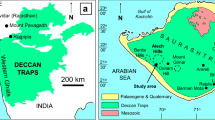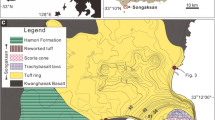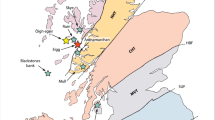Abstract
Non-welded rhyolitic pyroclastic units in the central Snake River Plain are interbedded with the much better exposed, large-volume ‘Snake-River type’ rheomorphic welded rhyolitic ignimbrites and rhyolite lavas. We document one such unit to investigate why it is so different from the interbedded welded ignimbrites. The newly recognised Deadeye Member of southern Idaho is a soil-bounded eruption-unit that comprises ashfall layers and a 4-m-thick ignimbrite that extends for >35 km. The ignimbrite is non-welded, lithic-clast poor and varies from massive to diffuse low-angle cross-bedded. It contains abundant angular clasts of non-vesicular black glass, and upper parts contain accretionary lapilli. The ashfall layers above it contain coated ash pellets and ash clumps, which record moist aggregation of fine ash. The magmas of the Deadeye eruption were closely similar in composition and temperature to those that generated the intensely welded rheomorphic ignimbrites of the central Snake River Plain. We infer that the marked contrast in physical appearance of the Deadeye ignimbrite compared to the other, more typical Snake-River-type welded ignimbrites was the result of emplacement at relatively low temperatures during an eruption in a lacustrine environment. Magmatic volatile-driven fragmentation of the rhyolitic magma was influenced by interaction with lake water that also led to cooling. The Deadeye Member is the first-recorded example of explosive silicic phreatomagmatism in the central Snake River Plain.











Similar content being viewed by others
References
Allen SR, Cas RAF (1998) Rhyolitic fallout and pyroclastic density current deposits from a phreatoplinian eruption in the eastern Aegean Sea, Greece. J Volcanol Geotherm Res 86:219–251
Anderson RS, Bunas KL (1993) Grain size segregation and stratigraphy in aeolian ripples modelled with a cellular automaton. Nature 365:740–743
Andrews GDM, Branney MJ, Bonnichsen B, McCurry M (2008) Rhyolitic ignimbrites in the Rogerson Graben, southern Snake River Plain volcanic province: volcanic stratigraphy, eruption history and basin evolution. Bull Volcanol 70:269–291
Aramaki S, Lipman P (1965) Possible leaching of Na2O during hydration of volcanic glasses. Proc Jpn Acad 41(6):467–470
Bonnichsen B (1982) The Bruneau-Jarbidge eruptive center; Southwestern Idaho. Idaho Bur Min Geol Bull 26:237–254, In: Bonnichsen B, Breckenridge RM (eds),Cenozoic Geology of Idaho
Bonnichsen B, Citron GP (1982) The Cougar Point Tuff, southwestern Idaho. Idaho Bur Mines Geol Bull 26:255–281, In: Bonnichsen B, Breckenridge RM (eds) Cenozoic Geology of Idaho
Bonnichsen B, Kauffman DF (1987) Physical features of rhyolite lava flows in the Snake River Plain volcanic province, southwestern Idaho. Spec Pap Geol Soc Am 212:119–145
Bonnichsen B, Leeman WP, Honjo N, McIntosh WC, Godchaux MM (2008) Miocene silicic volcanism in southwestern Idaho: geochronology, geochemistry, and evolution of the central Snake River Plain. Bull Volcanol 70:315–342
Boroughs S, Wolff J, Bonnichsen B, Godchaux M, Larson P (2005) Large-volume, low-δ18O rhyolites of the central Snake River Plain, Idaho, USA. Geology 33:821–824. doi:10.1130/G21723.1
Branney MJ (1991) Eruption and depositional facies of the Whorneyside Tuff: an exceptionally large-magnitude phreatoplinian eruption. Geol Soc Am Bull 203:886–897
Branney MJ, Kokelaar BP (1992) A reappraisal of ignimbrite emplacement: progressive aggradation and changes from particulate to non-particulate flow during emplacement of high-grade ignimbrite. Bull Volcanol 54:504–520
Branney MJ, Kokelaar BP (2002) Pyroclastic density currents and the sedimentation of ignimbrites. Geol Soc Lond Mem 27:1–152
Branney MJ, Bonnichsen B, Andrews GDM, Ellis B, Barry TL, McCurry M (2008) ‘Snake River (SR) -type’ volcanism at the Yellowstone hotspot track: distinctive products from unusual, high-temperature silicic super-eruptions. Bull Volcanol 70:293–314
Brown RJ, Branney MJ (2004) Event stratigraphy of a caldera-forming ignimbrite eruption on Tenerife: the 273 ka Poris Formation. Bull Volcanol 66:392–416
Brown RJ, Kokelaar BP, Branney MJ (2007) Widespread transport of pyroclastic density currents from a large silicic tuff ring: the Glaramara tuff, Scafell caldera, English Lake District, UK. Sedimentol 54(5):1163–1190. doi:10.1111/j.1365-3091.2007.00877.x
Brown RJ, Branney MJ, Maher C, Davila-Harris P (2010) Origin of accretionary lapilli within ground hugging density currents: Evidence from pyroclastic couplets on Tenerife. Geol Soc Am Bull 122:305–320
Carey SN, Sigurdsson H, Sparks RSJ (1988) Experimental studies of particle-laden plumes. J Geophys Res B93:1514–1528
Carey RJ, Houghton BF, Thordarson T (2009) Tephra dispersal and eruption dynamics of wet and dry phases of the 1875 eruption of Askja volcano, Iceland. Bull Volcanol. doi:10.1007/s00445-009-0317-3
Cashman KV, Mangan MT (1994) Physical aspects of magmatic degassing II. Constraints on vesiculation processes from textural studies of eruptive products. Rev Miner 30:447–478
Cathey HE, Nash BP (2004) The Cougar Point Tuff: implications for Thermochemical zonation and longevity of high-temperature, large volume silicic magmas of the Miocene Yellowstone hotspot. J Petrol 45:27–58
De Rita D, Giordano G, Esposito A, Fabbri M, Rodani S (2002) Large volume phreatomagmatic ignimbrites from the Colli Albani Volcano (Middle Pleistocene, Italy). J Volcanol Geotherm Res 118(1–2):77–98
Druitt TH, Sparks RSJ (1982) A proximal ignimbrite breccia facies on Santorini volcano, Greece. J Volcanol Geotherm Res 13:147–171
Eames I, Gilbertson M (2000) Aerated granular flow over a rigid horizontal surface. J Fluid Mech 424:169–195
Ellis B (2009) Rhyolitic explosive eruptions of the central Snake River Plain, Idaho: investigations of the lower Cassia Mountains succession and surrounding areas. Unpublished PhD thesis, University of Leicester, pp 169
Gilbert JS, Lane SJ (1994) The origin of accretionary lapilli. Bull Volcanol 56(5):398–411
Giordano G, De Rita D, Fabbri M, Rodani S (2002) Facies associations of rain-generated versus crater lake-withdrawl lahar deposits from Quaternary volcanoes, central Italy. J Volcanol Geotherm Res 118:145–159
Godchaux MM, Bonnichsen B (2002) Syneruptive magma-water and posteruptive lava-water interactions in the Western Snake River Plain, Idaho, during the past 12 million years. Idaho Geol Surv Bull 30:387–434, In: Bonnichsen B, White CM, McCurry M (eds) Tectonic and magmatic evolution of the Snake River Plain Volcanic Province
Heiken GH, Wohletz K (1985) Volcanic Ash. University of California, Berkeley, p 246
Henry CD, Castor SB, McIntosh WC, Heizler MT, Cuney M, Chemillac R (2006) Timing of oldest Steens basalt magmatism from precise dating of silicic volcanic rocks, McDermitt caldera and northwest Nevada Volcanic Field. Eos Trans AGU, 87(52), Fall Meet Suppl, Abstract V43D-12
Honjo N, Bonnichsen B, Leeman WP, Stormer JJC (1992) Mineralogy and geothermometry of high-temperature rhyolites from the central and western Snake River Plain. Bull Volcanol 54:220–237
Hunter RE (1977) Basic types of stratification in small eolian dunes. Sedimentology 24:361–387
Inman DL (1952) Measures for describing the size distribution of sediments. J Sed Res 22:125–145
Isaia R, D’Antonio M, Dell’Erba F, Di Vito M, Orsi G (2004) The Astroni volcano: the only example of closely spaced eruptions in the same vent area during the recent history of the Campi Flegrei caldera (Italy). J Volcanol Geotherm Res 133:171–192
Klug C, Cashman KV (1996) Permeability development in vesiculating magmas: implications for fragmentation. Bull Volcanol 58(2–3):87–100
Kneller BC, Branney MJ (1995) Sustained high-density turbidity currents and the deposition of thick massive sands. Sedimentology 42:607–616
Lanphere MA, Champion DE, Christiansen RL, Izett GA, Obradovich JD (2002) Revised ages for tuffs of the Yellowstone plateau volcanic field: Assignment of the Huckleberry Ridge Tuff to a new geomagnetic polarity event. Geol Soc Am Bull 114:559–568
Leeman WP, Annen C, Dufek J (2008) Snake River Plain - Yellowstone silicic volcanism: implications for magma genesis and magma fluxes. Geol Soc Lond Spec Publ 304:235–259. doi:10.1144/SP304.12
McCurry M (2009) The Arbon Valley Tuff: a new look at a highly anomalous ignimbrite from the Yellowstone-Snake River Plain volcanic track. Geol Soc Am Abstr Programs 41(6):43
McPhie J (1986) Primary and redeposited facies from a large magnitude, rhyolitic, phreatomagmatic eruption: Cana Creek Tuff, late Carboniferous, Australia. J Volcanol Geotherm Res 28:319–350
Perkins ME, Nash WP (2002) Explosive silicic volcanism of the Yellowstone hotspot: the ash fall tuff record. Geol Soc Am Bull 114:367–381
Perkins ME, Nash WP, Brown FH, Fleck RJ (1995) Fallout tuffs of Trapper Creek Idaho—a record of Miocene explosive volcanism in the Snake River Plains volcanic province. Geol Soc Am Bull 107:1484–1506
Pfeiffer T (2001) Vent development during the Minoan eruption (1640 BC) of Santorini as suggested by ballistic blocks. J Volcanol Geotherm Res 106:229–242
Pierce KL, Morgan LA (1992) The track of the Yellowstone hotspot: volcanism, faulting, and uplift. In: Link PK, Kuntz MA, Platt LB (eds) Regional Geology of Eastern Idaho and Western Wyoming. Geol Soc Am Mem 179:1–53
Rust AC, Cashman KV (2007) Multiple origins of obsidian pyroclasts and implications for changes in the dynamics of the 1300 B.P. eruption of Newberry Volcano, USA. Bull Volcanol 69:825–845. doi:10.1007/s00445-006-0111-4
Scolamacchia T, Macías JL, Sheridan MF, Hughes SR (2005) Morphology of ash aggregates from wet pyroclastic surges of the 1982 eruption of El Chichón volcano, Mexico. Bull Volcanol 68:171–200. doi:10.1007/s00445-005-0430-x
Self S (1983) Large-scale phreatomagmatic silicic volcanism: a case study from New Zealand. J Volcanol Geotherm Res 17:433–469
Self S, Sparks RSJ (1978) Characteristics of widespread pyroclastic deposits formed by the interaction of silicic magma and water. Bull Volcanol 41:196–21
Sheridan MF, Updike RG (1975) Sugarloaf Mountain tephra—a Pleistocene Rhyolitic Deposit of Base Surge Origin in Northern Arizona. Geol Soc Am Bull 86:571–581
Sisson TW (1995) Blast ashfall deposit of May 18, 1980 at Mount St Helens, Washington. J Volcanol Geotherm Res 66:203–216
Smith GA (1986) Coarse-grained nonmarine volcaniclastic sediment: terminology and depositional processes. Geol Soc Am Bull 97:1–10
Smith RT, Houghton BF (1995) Vent migration and changing eruptive style during the 1800a Taupo eruption: new evidence from the Hatepe and Rotongaio phreatoplinian ashes. Bull Volcanol 57:432–439
Svendsen J, Stollhofen H, Krapf CBE, Stanistreet IG (2003) Mass and hyperconcentrated flow deposits record dune damming and catastrophic breakthrough of ephemeral rivers, Skeleton Coast Erg, Namibia. Sed Geol 160:7–31
Talbot JP, Self S, Wilson CJN (1994) Dilute gravity current and rain-flushed ash deposits in the 1.8 ka Hatepe Plinian deposit, Taupo, New Zealand. Bull Volcanol 56:538–551
Walker GPL (1971) Grain-size characteristics of pyroclastic deposits. J Geol 79:696–714
Walker GPL (1981) Characteristics of two phreatoplinian ashes, and their water-flushed origin. J Volcanol Geotherm Res 9:395–407
Watanabe K, Ono K, Sakaguchi K, Takada K, Hoshizumi H (1999) Co-ignimbrite ashfall deposits of the 1991 eruptions of Fugen-dake, Unzen Volcano, Japan. J Volcanol Geotherm Res 89:95–112
Watson EB, Harrison TM (1983) Zircon saturation revisited: temperature and composition effects in a variety of crustal magma types. Earth Planet Sci Lett 64:295–304
White JDL, Houghton BF (2006) Primary volcaniclastic rocks. Geology 34(8):677–680. doi:10.1130/G22346.1
Williams PL, Mytton JA, Morgan WA (1999) Geologic map of the Stricker 3 quadrangle, Twin Falls and Cassia Counties, Idaho. US Geol Surv Misc Invest Ser Map I–2633, 1:48,000
Wilson CJN (2001) The 26.5 ka Oruanui eruption, New Zealand: an introduction and overview. J Volcanol Geotherm Res 112:133–174
Wohletz KH, Orsi G, de Vita S (1995) Eruptive mechanisms of the Neapolitan Yellow Tuff interpreted from stratigraphy, chemistry, and granulometry. J Volcanol Geotherm Res 67:263–290
Acknowledgements
A NERC studentship (NER/S/A/2004/12340) to BSE at the University of Leicester, and funds from the American Philosophical Society, NSF (NSF EAR-0911457) and NERC (NE/G005372/1) are gratefully acknowledged. We benefited from useful discussions with Bill Bonnichsen, Martha Godchaux and Mike McCurry, thorough and thoughtful reviews by Rebecca Carey and Darren Gravley, and editorial handling by Jocelyn McPhie.
Author information
Authors and Affiliations
Corresponding author
Additional information
Editorial responsibility: J. McPhie
Electronic supplementary material
Below is the link to the electronic supplementary material.
Rights and permissions
About this article
Cite this article
Ellis, B., Branney, M.J. Silicic phreatomagmatism in the Snake River Plain: the Deadeye Member. Bull Volcanol 72, 1241–1257 (2010). https://doi.org/10.1007/s00445-010-0400-9
Received:
Accepted:
Published:
Issue Date:
DOI: https://doi.org/10.1007/s00445-010-0400-9




